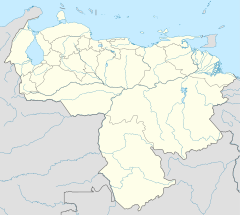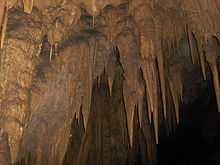El Guacharo National Park
| El Guacharo National Park | ||
|---|---|---|
| Cave entrance | ||
|
|
||
| Location: | Venezuela | |
| Next city: | Caripe | |
| Surface: | 627 km² | |
| Founding: | May 27, 1975 | |
The El Guácharo National Park ( Spanish : Parque Nacional El Guácharo) is located about 12 km from the village of Caripe in the state of Monagas in the Republic of Venezuela . The heart of the national park is the large stalactite cave Cueva del Guácharo.
Alexander von Humboldt and his friend, the young doctor and botanist Aimé Bonpland , explored the front section (the first 472 m of the cave) of this (at least) 10.2 km long stalactite cave in South America on September 18, 1799. Humboldt recognized that thousands of fat swallows (Spanish: guácharos; scientific name Steatornis caripensis ) that live in the cave belong to an unknown species of bird. Humboldt named the fruit-eating, nocturnal species after the village of Caripe. They shot two specimens and Humboldt reported that the residents collect the young birds shortly before they fledged and cook them for hours to obtain oil, which is where the English name "Oilbird" comes from.
The Cueva del Guácharo cave
The cave is a stalactite cave over 10 km long, with a number of large chambers and spectacular rock formations. The temperature inside the cave generally remains around 19 ° C and the humidity at 100%. The entrance to the cave is 23 m high and 28 m wide. There are guided tours in groups of 10 people. A first section of 1500 m can be visited normally. You pass the Humboldt Hall and the Galerie der Stille (with formations such as Cardón, Carmen's Virgin and Guard's Angel) and walk to the Hall of Sublime (sublime), where numerous stalactites and stalagmites were formed by the constant action of the water. A special permit is required for more detailed explorations.
Fat swallows
Fat swallows are fruit-eating birds that live in the first section of the cave. The birds produce an organic layer in the cave called guano , which is made up of excrement and vomited seeds, which provide the basic nutrients for the ecosystem in the cave.
The most important daily event in the park happens at dusk, when the birds leave the cave in large flocks in search of food.
protection
The cave was declared Venezuela's first natural monument "Monumento Natural Alejandro de Humboldt" after Decree No. 180 on July 15, 1949 .
The national park was established on May 27, 1975 to protect the cave and the surrounding forest ecosystem in which the fat swallows forage for food. The altitude of the national park is between 900 and 2340 m. There are 367 bird species in the national park, which is also an Important Bird Area (IBA). Although the fat Schwalme are not threatened with extinction, several other resident birds fall in the area under this category, as the mourning hooked beak (Diglossa venezuelensis) and the Berlepschsylphe (Aglaiocercus berlepschi) . The national park is part of the Cordillera de Caripe, Alliance for Zero Extinction (AZE), together with another IBA of the Zona Protectora Macizo Montañoso del Turimiquire.
Humboldt Museum
There is a Humboldt Museum near the cave entrance. It provides information about the cave, the national park, the fat swallows (guácharo) and Alexander von Humboldt.
Individual evidence
- ↑ The journey to the equinoxes of the New Continent in 1799, 1800, 1801, 1802, 1803 and 1804, Alexander von Humboldt, Aimé Bonpland (Vienna, 1827, etc.) Link to the beginning of the description of the cave in Project Gutenberg pg 354
- ↑ Archived copy ( memento of the original dated December 23, 2015 in the Internet Archive ) Info: The archive link was inserted automatically and has not yet been checked. Please check the original and archive link according to the instructions and then remove this notice.
- ^ BirdLife International (2015). Important Bird Areas factsheet: Parque Nacional El Guácharo (part of Cordillera de Caripe AZE) . Retrieved December 23, 2015 from http://www.birdlife.org



